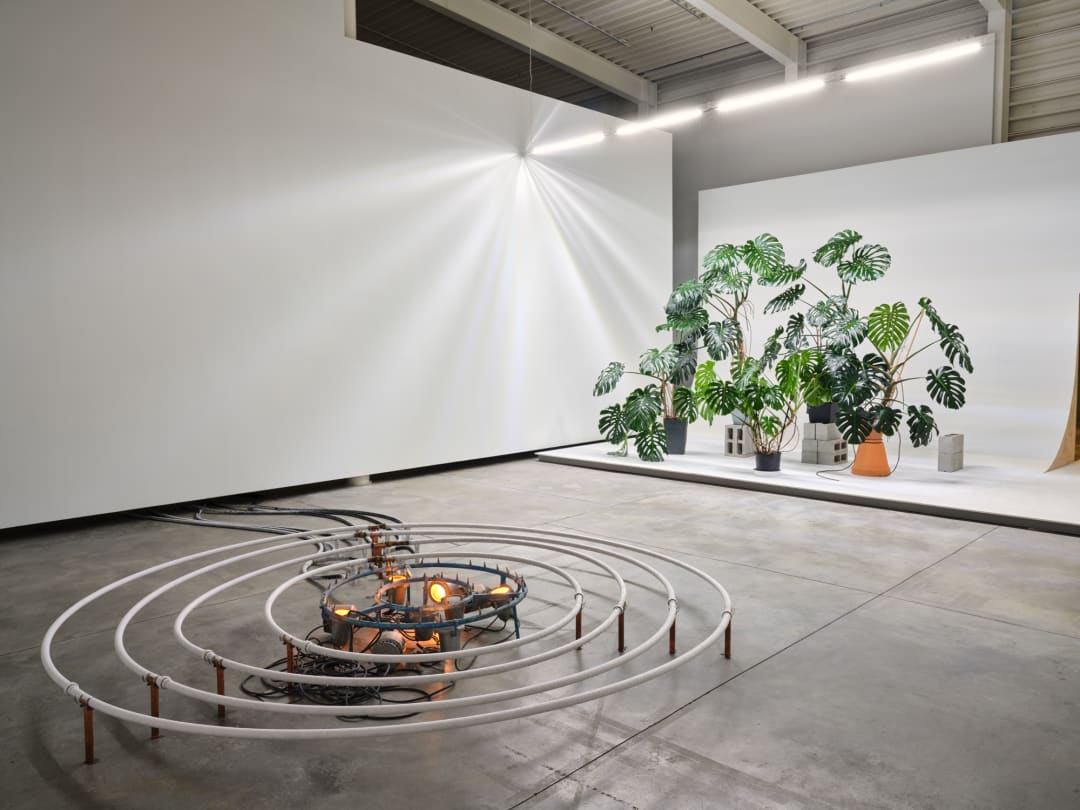The monstera plants tower over me as I walk into the exhibit. The bright white lights burn into my eyes before I fully understand what I’m looking at. Right in front of me is the pipework skeleton of a fountain, frigid droplets of water dripping down each second. Have I walked into the wrong room?
UBC MFA alumnus Abbas Akhavan’s exhibit, One Hundred Years, invites the audience to pause and exist in his enveloping displays. Akhavan is set to represent Canada at the 2026 Venice Biennale. Interestingly, despite its consistently intentional use of space, this exhibition is not one of Akhavan’s site-specific works.
“Site-specific work means it's just for this space and can't be anywhere else,” said Belkin Assistant Director and Curator Melanie O’Brian. “But [Akhavan] has thought so much about the space. We worked very closely to pace the way that the work unfolded.”
O’Brian began her work as a curator after writing her master’s thesis at the University of Chicago. She began working with Akhavan in 2012, where she included his work in a show for the Power Plant Contemporary Art Gallery in Toronto.
“I think he is one of our most interesting artists of this time, and was very, very happy to work with him on a solo project, which we began two and a half years ago,” she said. The Belkin team began building the exhibit in March of this year and finalized the showroom in August.
Akhavan’s work invites viewers to consider the world from a critical and modern perspective. With One Hundred Years, he asks the audience to think about what it means to be human in this day and age: what does it mean to be alive in a time of surveillance, political unrest and constant change? How do we balance perpetual human progression with the need for rest?
From the taxidermy animals to the intimidating entrance, the exhibit aims to elicit a visceral reaction from the audience. The artworks are striking as they tower over you, making you a part of the exhibit itself. It pulls you in with a curved wall, beckoning you to make a move. It is more than just walking through a gallery of pretty things put on display — One Hundred Years asks you to play its game.
“When you walk through that entrance into the gallery and you are both an actor; you’re a game piece, you are the one who [controls] how you make connections between these works and how you move in between them,” said O’Brian.
Akhavan and O’Brian grapple with these questions using the “Fatigues,” a series of taxidermy animals placed throughout the exhibition. Hidden behind a large water fountain on a greenscreen set, for example, is a taxidermy red fox. The little body interrupts the serenity of the water fountain, making you question whether or not it’s meant to be there. For a second, I feel frozen. Do I go tell the lady at the front desk that there’s a dead animal in here? Or is this part of the exhibit? Is it dead or just sleeping?
O’Brian said the placement of the fox is “very intentional.” The disruption caused by the “Fatigues” asks the audience to take a step back from the experience of walking through the gallery and ask themselves, ‘what is that?’
“I think [Akhavan] is interested in [giving] you space to elicit some of that thinking on your own behalf. It takes you out of the fact that you might be in a contemporary art gallery, and you refocus on what your relationship might be to this animal in front of you, whether this animal is sleeping or dead or exhausted. There's that question that kind of pulls you out of the art experience and makes you have this other quite intense personal experience.”
O’Brian and Akhavan encourage the audience to come up with their own interpretations of the works. Each piece allows for a subjective reading, catering to a wide and diverse audience, adding to the meaning of each display.
“[Akhavan] is really not very interested in a particular reading … There is a kind of openness to the way that people can project what they want to project onto it, and I think it's really beautiful. A lot of people are having quite emotional reactions and feeling quite strongly about what our own subjectivity is in relationship to our larger world and how these works crack open the way we perceive that.”
O’Brian hopes that viewers take away a nuanced perspective on ecology and our place in the world. “There’s a kind of grief, but also an incredibly persistent practice of hope and what we can still do around beauty and salvage in this world.”
One Hundred Years opened at the Belkin on Sept. 4, and will be open for free admission until Dec. 7.
Taken from The Ubyssey website.

